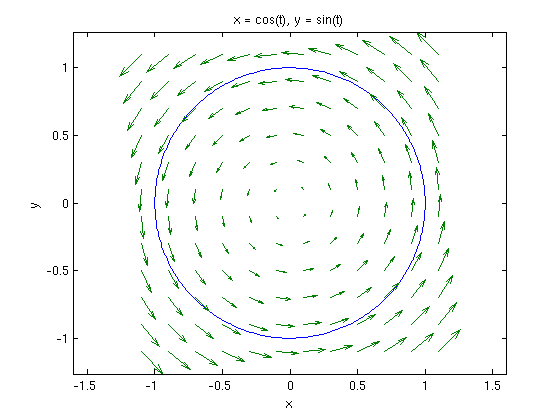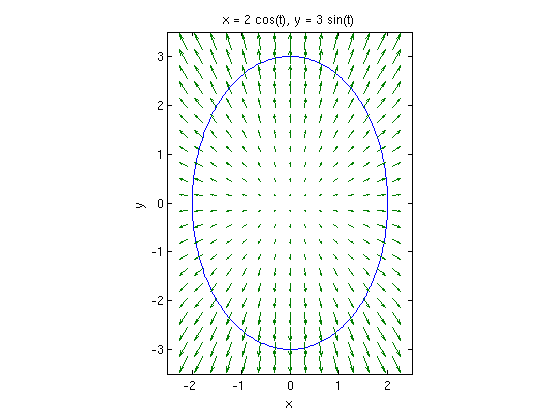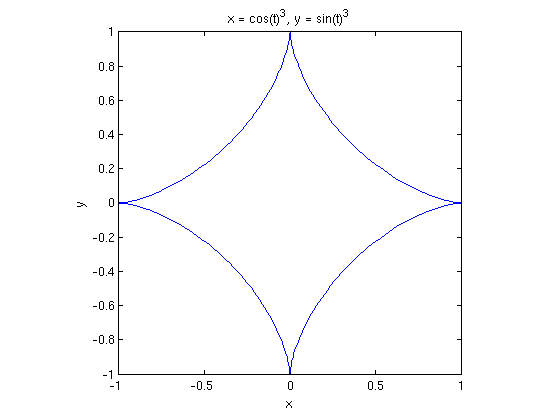Line Integrals Around Closed Curves and Green's Theorem
Nancy K. Stanton
based on original versions © 2000-2005 by Paul Green and Jonathan Rosenberg, modified with permission
Contents
Line Integrals Around Closed Curves
In the previous lesson, we evaluated line integrals of vector fields F along curves. We continue the study of such integrals, with particular attention to the case in which the curve is closed.
Example 1
We begin with the planar case. That means (if we think of F as being 3-dimensional) that the last component of F is 0, and the first two components only depend on x and y, not z. Let us consider

where C is the unit circle, and F is as defined in the input cell below.
syms x y F = [-y,x]
F = [ -y, x]
Before we evaluate the integral, let us plot the vector field F together with the unit circle. In order to get an intelligible plot, the step size in quiver must be taken relatively large. We begin by parametrizing the circle.
syms t circ = [cos(t), sin(t)]; ezplot(circ(1), circ(2), [0, 2*pi]), hold on [xx, yy] = meshgrid(-1.1:.2:1.1, -1.1:.2:1.1); quiver(xx, yy, -yy, xx), axis equal; hold off

It is evident from the plot that the vector field F is, in this case, everywhere tangent to the circle in the counterclockwise direction, so that the line integral should be positive. Now let us proceed to the evaluation. We use the fact that if  parametrizes the circle,
parametrizes the circle,

realdot = @(u, v) u*transpose(v); int(realdot(subs(F,[x,y],circ),diff(circ,t)),t,0,2*pi)
ans = 2*pi
Problem 1
Keeping C as the unit circle directed counterclockwise, let F2 and F3 be as defined below. Make a simultaneous plot of C with each of F2 and F3, and use it to predict what you can about

Then evaluate the integrals.
F2=[x,y] F3 = [ x+y, y-x]
F2 = [ x, y] F3 = [ x + y, y - x]
Green's Theorem
Green's Theorem states that if D is a plane region with boundary curve C directed counterclockwise and F = [P, Q] is a vector field differentiable throughout D, then

Example 2
With F as in Example 1, we can recover P and Q as F(1) and F(2) respectively and verify Green's Theorem. We will, of course, use polar coordinates in the double integral.
syms r
integrand=diff(F(2),x)-diff(F(1),y)
polarint=r*subs(integrand,[x,y],[r*cos(t),r*sin(t)])
symint2(polarint,r,0,1,t,0,2*pi)
integrand = 2 polarint = 2*r ans = 2*pi
Problem 2
Verify Green's Theorem for vector fields F2 and F3 of Problem 1.
More on Green's Theorem
Green's Theorem can also be interpreted in terms of two-dimensional flux integrals and the two-dimensional divergence. We recall that if C is a closed plane curve parametrized by  in the counterclockwise direction then
in the counterclockwise direction then
![$$\overrightarrow T\,ds = \frac{d\overrightarrow r}{dt}\,dt =
\left[ \frac{dx}{dt} , \, \frac{dy}{dt} \right] \,dt$$](green_eq23000.png)
and
![$$\overrightarrow n\,ds =
\left[ \frac{dy}{dt} , \, \mbox{--}\, \frac{dx}{dt} \right]\,dt ,$$](green_eq61587.png)
where n here denotes the outward unit normal to C in the xy-plane. Then if F is a vector field, we have

while
![$$ \overrightarrow F \cdot \overrightarrow n\,ds =
\overrightarrow F(1)\,dy \,\,\mbox{--}\,\, \overrightarrow F(2)\,dx
= \left[ \mbox{--}\, \overrightarrow F(2), \overrightarrow F(1)\right]
\cdot \overrightarrow T\,ds. $$](green_eq66191.png)
It now follows from Green's Theorem that

where the divergence has essentially the same meaning in two dimensions as in three. The integral

is the flux of  through C.
through C.
Example 3
We will now take C to be the ellipse

so that D is the region inside the ellipse. We will compute

two different ways, where F5 is as defined below.
F5 = [4*x, 5*y]
F5 = [ 4*x, 5*y]
Let us begin by plotting the ellipse and the vector field. We will use modified polar coordinates for the ellipse.
ellipse=[2*cos(t),3*sin(t)] ezplot(ellipse(1), ellipse(2), [0, 2*pi]) hold on [xx, yy] = meshgrid(-2.1:.3:2.1,-3.15:.3:3.15); quiver(xx, yy, 4*xx, 5*yy) axis equal, axis([-2.5,2.5,-3.5,3.5]), hold off
ellipse = [ 2*cos(t), 3*sin(t)]

From the fact that all the arrows point outward across the ellipse, we expect a positive answer to our computation.
F5ell=subs(F5,[x,y],ellipse) int(realdot([-F5ell(2),F5ell(1)],diff(ellipse,t)),t,0,2*pi)
F5ell = [ 8*cos(t), 15*sin(t)] ans = 54*pi
We now parametrize the region inside the ellipse by introducing a factor of r, which will run from 0 to 1. Since we are not using standard polar coordinates, we will need to compute the scale factor for integrating in this coordinate system.
region=r*ellipse scale=det(jacobian(region,[r,t]))
region = [ 2*r*cos(t), 3*r*sin(t)] scale = 6*r*cos(t)^2 + 6*r*sin(t)^2
We compute the divergence of F5 exactly as though it were a three-dimensional vector field, except that we do not need to specify a third variable.
divF5=div(F5,[x,y])
divF5 = 9
Since the divergence of F5 is constant, we do not need to carry out a coordinate substitution, but can proceed with the integration.
symint2(divF5*scale,r,0,1,t,0,2*pi)
ans = 54*pi
Problem 3
Based on your plots from Problem 1, make what predictions you can about the sign of the flux of F2 and F3 through the unit circle. Then verify Green's Theorem by computing the flux two different ways.
The Connection with Area
A curious consequence of Green's Theorem is that the area of the region D enclosed by a simple closed curve C in the plane can be computed directly from a line integral over the curve itself, without direct reference to the interior. The reason is that if we take F = [P, Q] and choose P and Q so that

then
![$$ \int_C [P, Q] \cdot
\overrightarrow T\,ds,$$](green_eq10176.png)
is just the area of R,

Example 4
Let's find the area enclosed by the astroid C:

We could of course solve for y in terms of x and integrate, but that would give us a messy function that MATLAB can't integrate symbolically. So there's a better way. First we parametrize the curve, using the fact that the change of variables  converts the curve to a circle
converts the curve to a circle  , which has a parametrization
, which has a parametrization  . So we can take
. So we can take
astroid=[cos(t)^3,sin(t)^3]
astroid = [ cos(t)^3, sin(t)^3]
If we take F = [0, x], then the line integral of F will be precisely the area enclosed by C. The line integral is just

So
astroidarea=int(astroid(1)*diff(astroid(2)),t,0,2*pi)
astroidarea = (3*pi)/8
That's 3/8 of the area of a circular disk of radius 1. Here is the picture:
ezplot(astroid(1),astroid(2), [0, 2*pi]); axis equal; axis([-1,1,-1,1])
